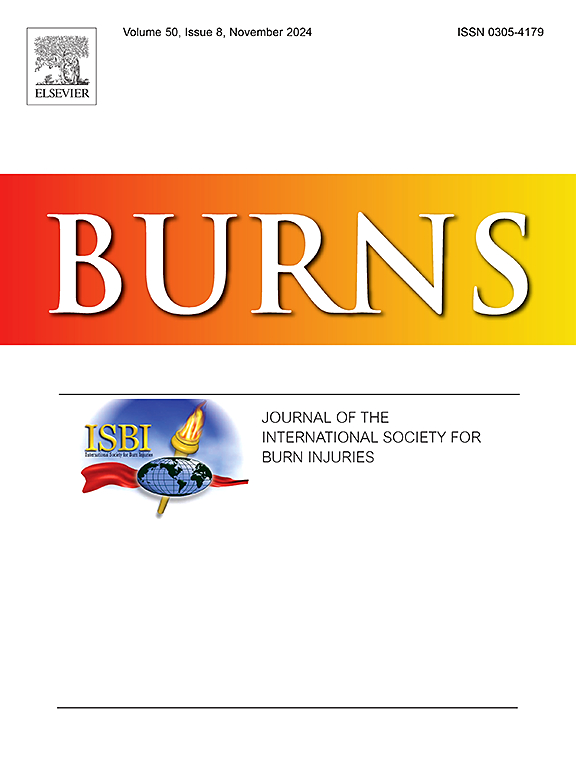Comparison of peripherally inserted central catheters and central venous catheters in burn patients: a retrospective cohort study
IF 2.9
3区 医学
Q2 CRITICAL CARE MEDICINE
引用次数: 0
Abstract
Background
Central venous access devices, including peripherally inserted central catheters (PICCs) and central venous catheters (CVCs), are common treatment measures in burn patients. However, how to choose between PICCs and CVCs remains unclear. This study compared the clinical outcomes of CVCs and PICCs in burn patients.
Methods
This retrospective cohort study was performed in a major burn center in southwest China with 1500 burn patients admitted per year. All the burn patients receiving PICCs or CVCs were included. Catheter-related venous thrombosis (CRT), catheter-related infection (CRI), and infection profiles were analyzed.
Results
A total of 642 CVCs and 111 PICCs in 255 burn patients were included. The incidence of CRT in CVCs and PICCs were similar (CVCs: 4.7 % vs. PICCs: 5.4 %, p = 0.738). CVCs had higher incidence of catheter colonization (CVCs: 39.9 %, 42.4 per 1000 catheter-days vs. PICCs: 7.2 %, 2.86 per 1000 catheter-days, p < 0.001) and of catheter-related blood stream infection (CRBSI) (CVCs: 14.5 %, 15.43 per 1000 catheter-days vs. PICCs: 0.9 %, 0.36 per 1000 catheter-days, p < 0.001). Subgroup analyses stratified by total burn area, age, Baux score, pulmonary infection, shock, total parenteral nutrition, in-bed days, and operation times confirmed PICCs had similar CRT rate and lower CRI rate. CVCs were predominantly colonized by A. baumannii (32 %), P. aeruginosa (19.2 %) and S. aureus (18.3 %), and PICCs were mainly colonized by P. aeruginosa (40 %) and S. aureus (30 %). 77 % of colonizing bacteria of CVCs were multiple-drug resistant (MDR), and 80 % of colonizing bacteria of PICCs were MDR. There were no significant differences in CRIs among CVCs through femoral, internal jugular and subclavian veins. Internal jugular CVCs had significantly higher CRT rate than did femoral CVCs (10.0 % vs. 3.9 %, p = 0.021).
Conclusion
PICCs had a lower risk of catheter-related infection and a similar rate of catheter-related thrombosis than CVCs, particularly femoral CVCs. Multicenter randomized clinical trials are needed to validate these findings in the future.
烧伤患者外周置置中心导管与中心静脉导管的比较:一项回顾性队列研究
中心静脉通路装置,包括外周插入中心导管(PICCs)和中心静脉导管(CVCs),是烧伤患者常用的治疗措施。然而,如何在picc和cvc之间做出选择仍不清楚。本研究比较了烧伤患者cvc和PICCs的临床结果。方法回顾性队列研究在中国西南地区某大型烧伤中心进行,该中心每年收治1500例烧伤患者。所有接受PICCs或cvc的烧伤患者均被纳入。分析导管相关性静脉血栓形成(CRT)、导管相关性感染(CRI)和感染概况。结果255例烧伤患者共检测cvc 642例,PICCs 111例。CRT在CVCs和PICCs中的发生率相似(CVCs: 4.7 % vs. PICCs: 5.4 %,p = 0.738)。CVCs患者的导管定植发生率较高(CVCs: 39.9 %,42.4 / 1000导管天,PICCs: 7.2 %,2.86 / 1000导管天,p <; 0.001),导管相关血流感染(CRBSI)发生率较高(CVCs: 14.5 %,15.43 / 1000导管天,PICCs: 0.9 %,0.36 / 1000导管天,p <; 0.001)。按烧伤面积、年龄、Baux评分、肺部感染、休克、总肠外营养、卧床天数和手术次数分层的亚组分析证实PICCs的CRT率相似,CRI率较低。cvc以鲍曼不动杆菌(32 %)、铜绿假单胞菌(19.2 %)和金黄色葡萄球菌(18.3 %)为主,PICCs以铜绿假单胞菌(40 %)和金黄色葡萄球菌(30 %)为主。CVCs定殖菌中77 %为多药耐药(MDR), PICCs定殖菌中80 %为多药耐药(MDR)。经股静脉、颈内静脉和锁骨下静脉的cvc的cri无显著性差异。颈内静脉冠脉造影的CRT率明显高于股动脉冠脉造影(10.0 % vs. 3.9 %,p = 0.021)。结论piccs发生导管相关感染的风险较cvc低,导管相关血栓形成的发生率与cvc相当,尤其是与股动脉cvc。未来需要多中心随机临床试验来验证这些发现。
本文章由计算机程序翻译,如有差异,请以英文原文为准。
求助全文
约1分钟内获得全文
求助全文
来源期刊

Burns
医学-皮肤病学
CiteScore
4.50
自引率
18.50%
发文量
304
审稿时长
72 days
期刊介绍:
Burns aims to foster the exchange of information among all engaged in preventing and treating the effects of burns. The journal focuses on clinical, scientific and social aspects of these injuries and covers the prevention of the injury, the epidemiology of such injuries and all aspects of treatment including development of new techniques and technologies and verification of existing ones. Regular features include clinical and scientific papers, state of the art reviews and descriptions of burn-care in practice.
Topics covered by Burns include: the effects of smoke on man and animals, their tissues and cells; the responses to and treatment of patients and animals with chemical injuries to the skin; the biological and clinical effects of cold injuries; surgical techniques which are, or may be relevant to the treatment of burned patients during the acute or reconstructive phase following injury; well controlled laboratory studies of the effectiveness of anti-microbial agents on infection and new materials on scarring and healing; inflammatory responses to injury, effectiveness of related agents and other compounds used to modify the physiological and cellular responses to the injury; experimental studies of burns and the outcome of burn wound healing; regenerative medicine concerning the skin.
 求助内容:
求助内容: 应助结果提醒方式:
应助结果提醒方式:


